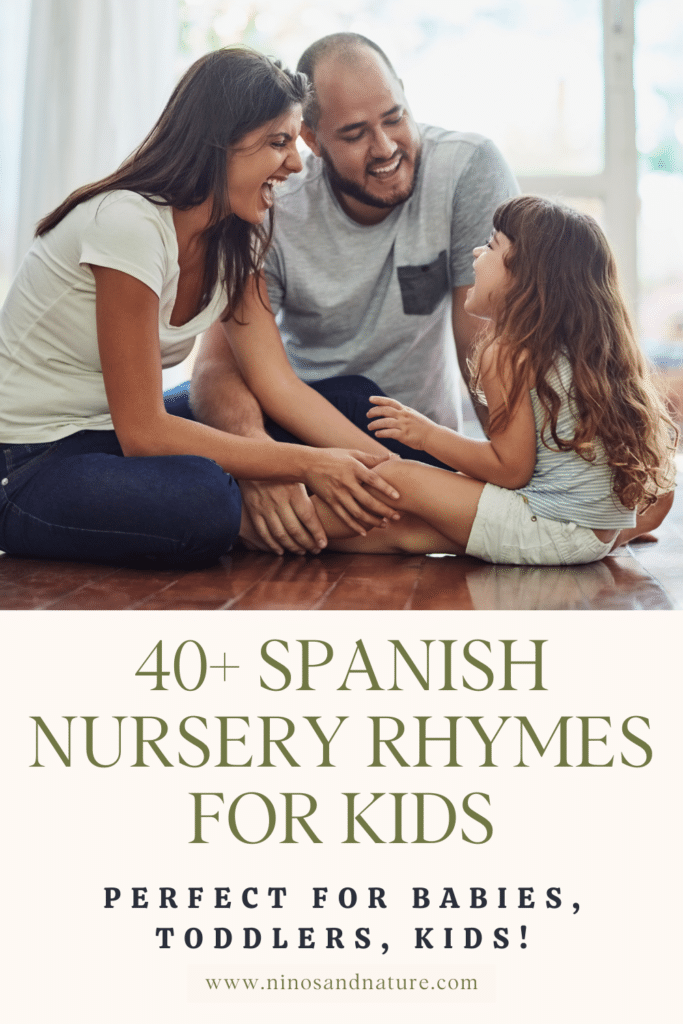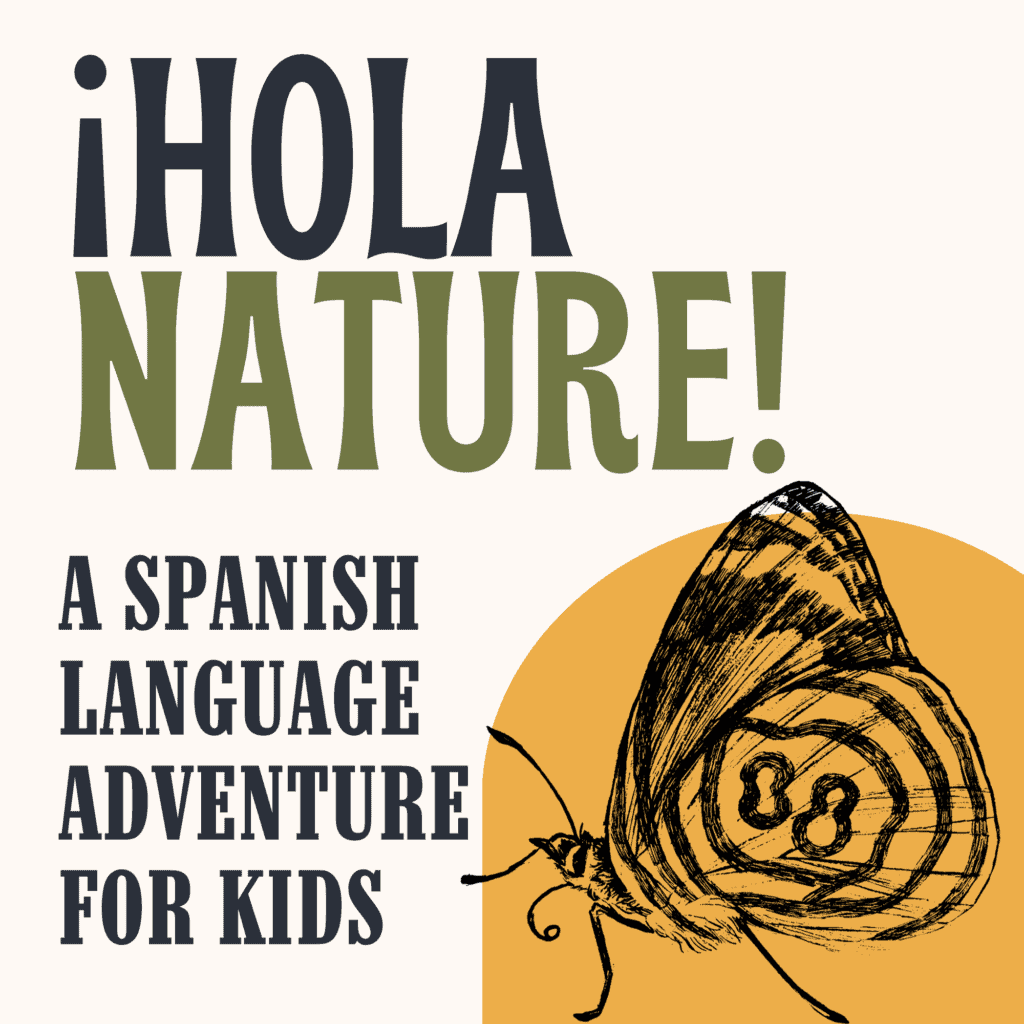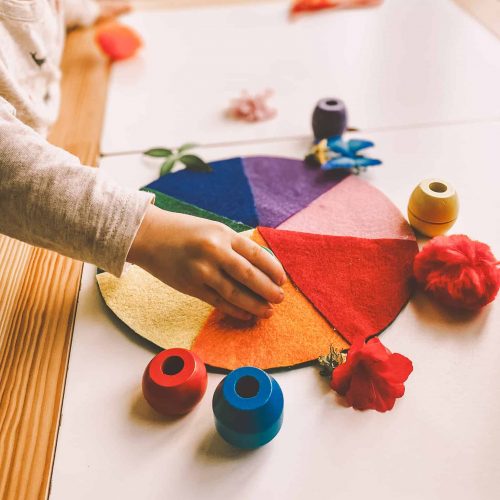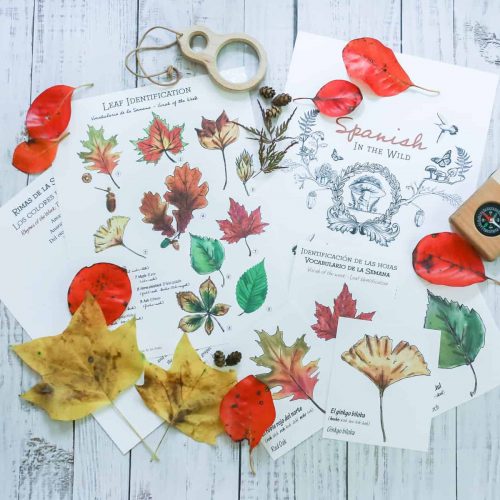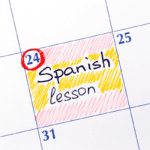
30+ Popular Spanish Nursery Rhymes for kids: Rimas para niños
In this post: Learn over 30 popular Spanish nursery rhymes to teach your children or students! Post contains affiliate links.
If you’re looking for fun and easy ways to introduce Spanish to your little ones, look no further! Spanish nursery rhymes are a fantastic tool to help kids learn new words, sounds, and phrases en español—all while having fun. Below, you’ll find 30 popular nursery rhymes in Spanish that are perfect for babies, toddlers, and preschoolers (or really any Spanish learners!)
Each nursery rhyme uses repetition, rhythm, and playful lyrics to engage kids and help them remember new vocabulary. Whether you’re a parent, a teacher, or a homeschooler, these rhymes will help make Spanish learning a fun part of your child’s routine.
Table of Contents
Why Nursery Rhymes Are Great for Learning Spanish
Nursery rhymes have been used for generations to entertain and teach young children. In addition to being a fun activity, they offer key benefits for language learning:
- Rhyme and Repetition: Rhyming patterns help children recognize similar sounds, which boosts phonemic awareness—a critical skill in learning to read and speak fluently.
- Vocabulary Building: Spanish nursery rhymes introduce new words and phrases, helping your child expand their vocabulary en español naturally.
- Listening and Speaking Practice: As children listen to and recite rhymes, they strengthen their listening skills and develop proper pronunciation and intonation in a fun way.
- Cultural Connection: Many of these rhymes have deep cultural roots in Spanish-speaking countries, providing a fun way to connect with Spanish traditions and heritage.
How to Use These Spanish Rhymes at Home
To get the most out of these rimas para niños, try the following tips:
- Sing and Repeat: Sing or chant the rhymes with your child, encouraging them to repeat after you. Repetition is key to learning!
- Listen: Remember my blog is enabled with text to speech in Spanish! Simply highlight any nursery rhyme you want to hear, then click the blue icon and listen to it read out loud en español!
- Get Moving: Incorporate movement by acting out the rhymes. Whether it’s clapping, dancing, or mimicking actions mentioned in the rhyme, movement helps reinforce learning.
- Turn It into an Art Project: Create simple art activities related to the rhyme. For example, after singing “Saco una Manito,” your child could draw their hand or trace it to add a creative element.
- Watch the Videos: At the end of this post, I’ve included videos of some popular rhymes to help you learn to since them at home.

30+ Fun Spanish Nursery Rhymes to Enjoy with Your Little Ones
Next, you’ll find a collection of 30+ engaging Spanish nursery rhymes perfect for babies, toddlers, and preschoolers learning español. These rimas para niños combine repetition, rhythm, and fun language patterns that help young children naturally absorb Spanish. Whether you’re looking to introduce new vocabulary, reinforce listening skills, or just have a good time singing together, these Spanish nursery rhymes are the perfect place to start.
You can sing them during daily routines, car rides, or playtime—no screen required! Plus, you’ll find that many of these rhymes are paired with fun movements or games, making them even more engaging for your little ones.
Saco Una Manito
First, we’ll start with this interactive rhyme that encourages children to move their hands, open and close them, and hide them again. It’s perfect for teaching body parts and practicing fine motor skills. *You can also say manita instead of manito – the difference is regional preference*
Rima:
Saco una manito,
la hago bailar.
La cierro, la abro
y la vuelvo a guardar.
Saco otra manito,
la hago bailar.
La cierro, la abro
y la vuelvo a guardar.
Saco las dos manitos,
las hago bailar.
Las cierro, las abro
y las vuelvo a guardar.
Un Ratoncito Sale de la Cueva
A counting rhyme that introduces children to numbers in a playful way. Encourage your little one to use their fingers to count along with the rhyme.
Rima:
Un ratoncito sale de la cueva,
mueve el hocico y juega a la rueda.
Dos ratoncitos salen de la cueva,
mueven el hocico y juegan a la rueda.
Tres ratoncitos salen de la cueva,
mueven el hocico y juegan a la rueda.
(Sigue contando…)
Mi Granja
This fun Spanish nursery rhyme teaches animal sounds and introduces vocabulary related to farm animals. Encourage children to make the animal sounds as you go through the rhyme together.
Rhyme:
Vengan a ver mi granja, vengan todos,
vengan a ver mi granja que es hermosa,
y el perro hace así: guau, guau, guau,
y el perro hace así: guau, guau, guau.
Coro:
O vengan amigos, vengan amigos,
vengan amigos, vengan.
Vengan amigos, vengan amigos, vengan
amigos, vengan.
Vengan a ver mi granja, vengan todos,
vengan a ver mi granja que es hermosa,
y la vaca hace así: muu,
y la vaca hace así: muu.
Vengan a ver mi granja, vengan todos,
vengan a ver mi granja
que es hermosa,
y el cerdo hace así:
oinc, oinc,
y el cerdo hace así:
oinc, oinc.
Este Dedito
A cute finger play rhyme where each finger takes on a fun role. This is a great rhyme for developing coordination and vocabulary.
Rhyme:
Este dedito compró un huevito,
este lo cocinó,
este le echó la sal,
este lo probó,
y este pícaro gordo, se lo comió.
Vamos a Remar
A great rhyme to encourage movement! Kids can pretend they’re rowing a boat, flying an airplane, or riding in a car as they chant this rhyme.
Rhyme:
Vamos a remar
en un botecito
rápido, rápido, rápido, rápido
en un botecito.
Vamos a volar
en un avioncito
rápido, rápido, rápido, rápido
en un avioncito.
Vamos a pasear
en un cochecito
rápido, rápido, rápido,
rápido en
un cochecito.
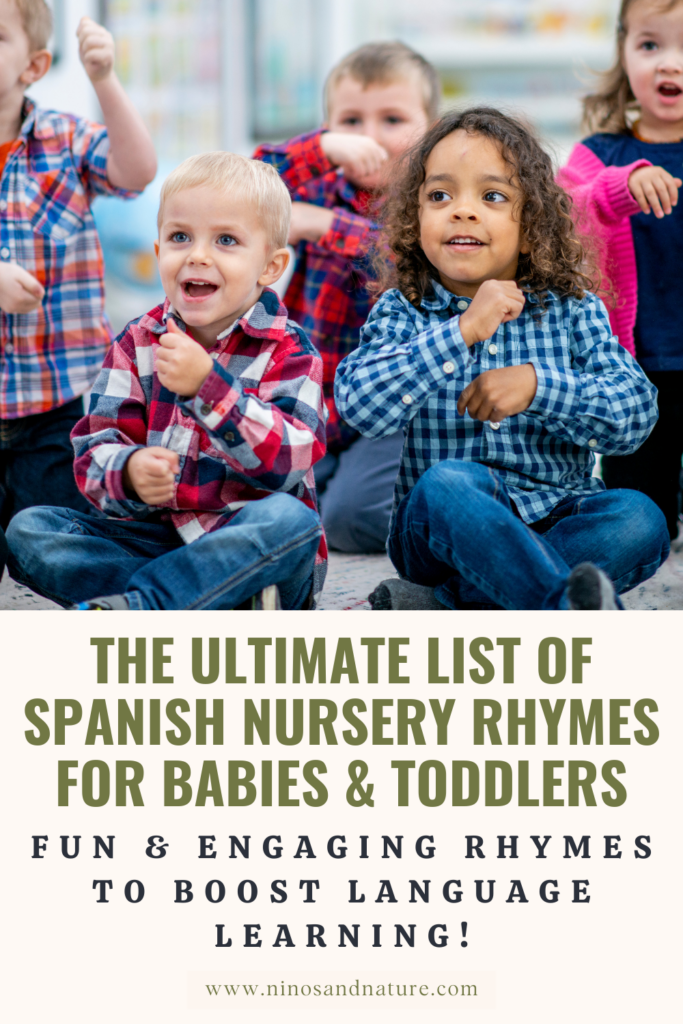
Bate Chocolate
This rhyme is perfect for teaching rhythm and coordination. Kids can rub their hands together as if they are stirring chocolate in a pot. It’s also a great way to learn about how chocolate caliente is made in Mexico with a molinillo!
Rhyme:
Uno dos tres CHO
Uno dos tres CO
Uno dos tres LA
Uno dos tres TE
Chocolate, chocolate
¡Bate, bate, chocolate!
Din Don Dan
A simple and fun rhyme that introduces sounds and can be paired with hand bells or other noisemakers.
Rhyme:
Din, don, dan,
repican las campanas,
din, don, dan,
alegran la mañana.
Mi Perro Bingo
A fun adaptation of the classic Bingo song, great for practicing letters, rhythm, and listening skills.
Rhyme:
Un perro grande tengo yo y él se llama Bingo,
B-I-N-G-O, B-I-N-G-O, B-I-N-G-O
y él se llama Bingo.
(Replace one letter with a clap each time.)
Aplaude I-N-G-O, aplaude I-N-G-O,
aplaude I-N-G-O
y él se llama Bingo.
Mi Carita
This rhyme introduces facial features in a playful way, helping children identify their own body parts.
Rhyme:
Yo tengo una carita
que parece una casita.
Los pelos de la cabeza
parece que son las tejas,
los ojos son dos ventanas
que se abren por las mañanas.
La boca la tengo abierta,
parece que es una puerta ¡aaaaaaaa!
y en el centro una nariz
que es un timbre y hace así ¡riiiin, riiiin!
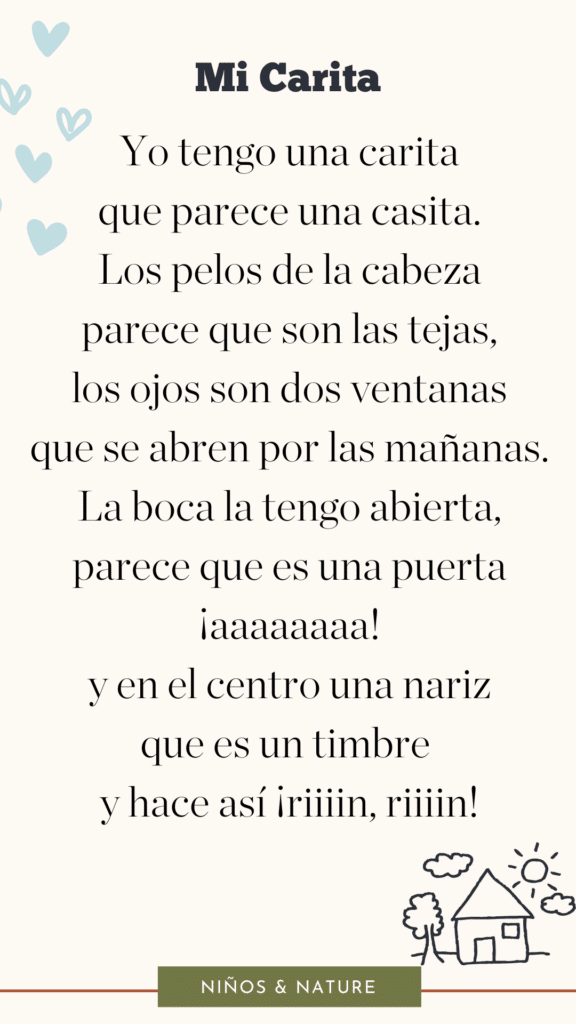
Las Manitos
This rhyme, set to the melody of “Are You Sleeping?”, is a simple, catchy way to engage kids in movement while teaching them hand coordination.
Rhyme:
Las manitos, las manitos,
aquí están, aquí están.
Ellas se saludan, ellas se saludan,
y se van, y se van.
Las Ruedas del Autobús
A beloved classic, this Spanish nursery rhyme helps children learn about everyday things they encounter, like buses, while engaging in fun movements like “going round and round.”
Rhyme:
Las ruedas del autobús dan vueltas y vueltas,
dan vueltas y vueltas, vueltas y vueltas… por la ciudad.
La gente en el autobús sube y baja,
sube y baja, sube y baja… por la ciudad.
La bocina del autobús suena piii piii,
suena piii piii, suena piii piii… por la ciudad.
Los bebés en el autobús lloran y lloran,
lloran y lloran, lloran y lloran… por la ciudad.
Los padres en el autobús dicen shh, shh, shh,
dicen shh, shh, shh, dicen shh, shh, shh… por la ciudad.
Aquel Caracol
A sweet rhyme that can be paired with a snail craft or activity to reinforce vocabulary related to nature.
Rhyme:
Aquel caracol
que va por el sol
en cada ramita
que lleva una flor.
Que viva la gracia,
que viva el amor,
que viva la gracia
de aquel caracol.
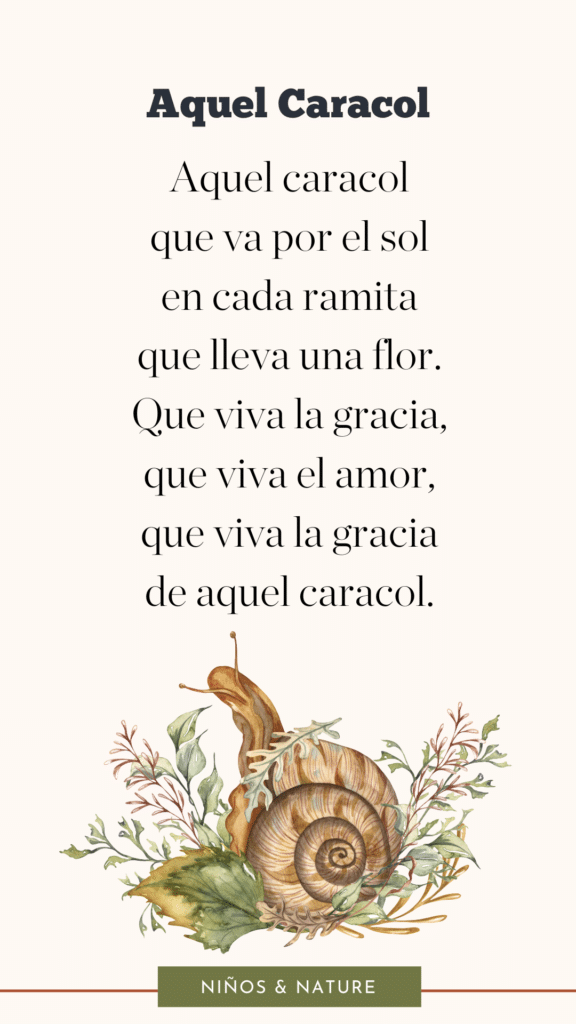
El Pollo
This simple and repetitive rhyme can be paired with a fun chicken dance, helping toddlers with body movement and coordination.
Rhyme:
El pollo con una pata.
El pollo con la otra pata.
El pollo con el piquito.
El pollo con las alitas.
¡El pollo con la colita!
Veo Veo
A classic rima para niños that plays a guessing game with letters and vocabulary. It’s great for developing phonemic awareness and early letter recognition.
Rhyme:
Veo, veo.
¿Qué ves?
Una cosita.
¿Y qué cosita es?
Comienza con la Aa.
¿Qué será, qué será, qué será?
Comienza con la Ee.
¿Qué seré, qué seré, qué seré?
Comienza con la Ii.
¿Qué serí, qué serí, qué serí?
Comienza con la Oo.
¿Qué seró, qué seró, qué seró?
Comienza con la Uu.
¿Qué serú, qué serú, qué serú?
El Barco Chiquitito
This rhyme can be sung in a repetitive pattern, helping kids understand story structure. You can act out the story as if you’re sailing in a little boat.
Rhyme:
Había una vez un barco chiquitito,
había una vez un barco chiquitito,
había una vez un barco chiquitito
que no podía, que no podía, que no podía navegar.
Pasaron una, dos, tres, cuatro, cinco,
seis, siete semanas,
pasaron una, dos, tres, cuatro, cinco,
seis, siete semanas,
y el barquito que no podía, que no podía navegar.
Y si esta historia no les parece larga,
la volveremos a empezar.
Cabeza, Hombros, Rodillas, Pies
This action-packed rhyme is fantastic for learning body parts and getting kids to move and follow along with the lyrics.
Rhyme:
Cabeza, hombros, rodillas, pies, rodillas y pies.
Cabeza, hombros, rodillas, pies, rodillas y pies.
Ojos, orejas, boca y nariz,
cabeza, hombros, rodillas, pies, rodillas y pies.
Pajarito que Cantas en la Laguna
A gentle lullaby-style rhyme that can be used during quiet moments or naptime. It teaches imagery and vocabulary related to nature.
Rhyme:
Pajarito que cantas en la laguna
no despiertes al niño que está en la cuna.
Ea la nana, ea la nana,
duérmete lucerito que es la mañana.
La cuna de mi niño se mece sola,
como en el campo verde, las amapolas.
Ea la nana, ea la nana,
duérmete lucerito que es la mañana.
Yo Tengo Una Casita
A simple, repetitive rhyme that introduces vocabulary related to houses. You can have kids pretend to knock on doors or point to different parts of their house as you sing.
Rhyme:
Yo tengo una casita, así, así,
con una ventanita, así, así,
yo llamo a la puertita, así, así,
y por la chimenea sale el humo así, así.
Yo tengo una casota, así, así,
con una ventanota, así, así,
yo llamo a la puertota, así, así,
y por la chimenea sale el humo así, así.
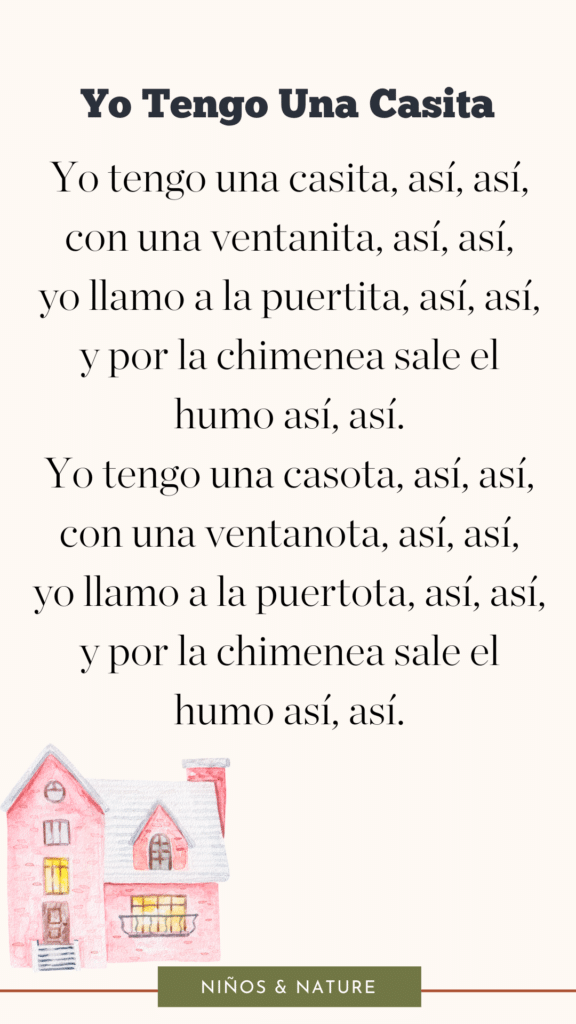
La Vaca Lola
One of the most popular Spanish nursery rhymes for introducing children to animal sounds. You can encourage kids to moo along with the rhyme.
Rhyme:
La vaca Lola, la vaca Lola
tiene cabeza y tiene cola.
La vaca Lola, la vaca Lola
tiene cabeza y tiene cola
y hace muu.
El Invierno Ya Llegó
This rhyme teaches about the winter season and helps children learn vocabulary related to cold weather and dressing warmly.
Rhyme:
El invierno ya llegó,
corre que te corre
y tendrás calor.
Si hace frío,
guantes y bufanda.
Si ha nevado,
gorro con pompón.
Si es que llueve,
abre tu paraguas.
¡El invierno ya llegó!
¡El invierno ya llegó!
Los Elefantes
A classic counting rhyme where elephants balance on a spider’s web. Kids love counting along, and it can be expanded infinitely.
Rhyme:
Un elefante se balanceaba
sobre la tela de una araña.
Como veía que resistía,
fue a llamar a otro elefante.
Dos elefantes se balanceaban
sobre la tela de una araña.
Como veían que resistía,
fueron a llamar a otro elefante.
(Sigue contando…)
Tres Pececitos
This rhyme introduces children to underwater creatures and helps teach them numbers and animal behavior.
Rhyme:
Tres pececitos se fueron a nadar,
el más chiquito se fue al fondo del mar,
y un tiburón le dijo: ven acá.
No, no, no, no, no, porque se enoja mi mamá.
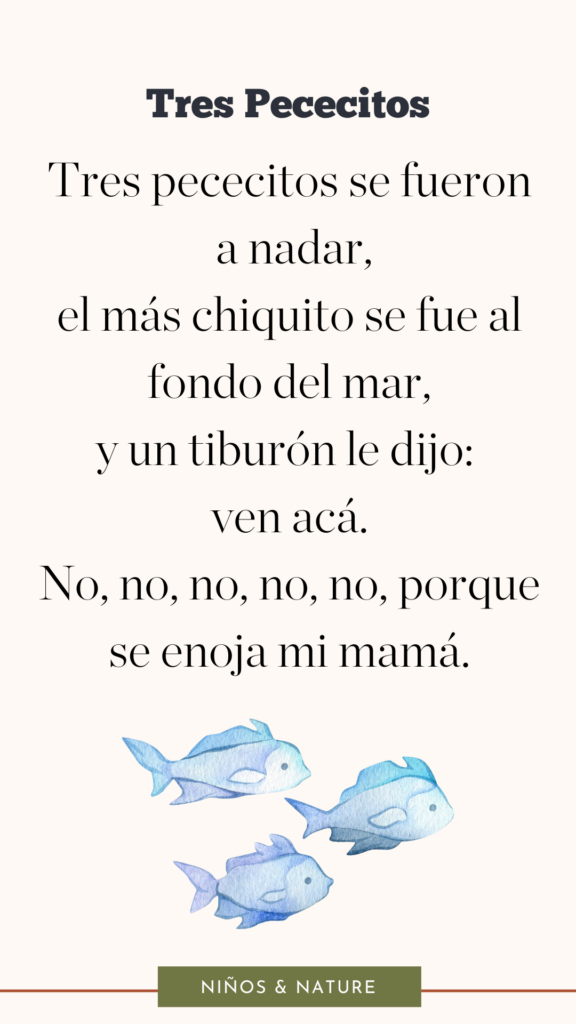
Abre, Cierra
A great rhyme for teaching motor skills, where kids open and close their hands along with the lyrics.
Rhyme:
Abre, cierra, abre, cierra
da una palmadita, ta.
Abre, cierra, abre, cierra,
ponlos en tu regazo, zo.
Este es un Gato
A fun and silly rhyme about a cat with fabric ears and a reversed belly. It’s perfect for acting out with hand movements or a toy cat.
Rhyme:
Este es un gato con las orejas de trapo
y la barriga del revés.
¿Quieres que te lo cuente otra vez?
¿Sí? Vale:
Este es un gato con las orejas de trapo
y la barriga del revés.
¿Quieres que te lo cuente otra vez?
Elena la Ballena
This is one of my favorite Spanish nursery rhymes for kids about a whale named Elena is a fun introduction to marine life vocabulary and concepts like depth and the sea.
Rhyme:
Elena, Elena, Elena la ballena
vivía, vivía, vivía allá en el mar,
en el agua azul, le gustaba nadar,
en el agua azul, le gustaba jugar.
¡Qué hondo! ¡Qué hondo!
¡Qué hondo es el mar!
¡Qué hondo! ¡Qué hondo!
¡Qué hondo es el mar!
Sol Solecito
A short and sweet rhyme about the sun, perfect for morning routines or outdoor activities.
Rhyme:
Sol solecito
caliéntame un poquito.
Por hoy, por mañana,
por toda la semana.
Lunes, martes, miércoles, jueves,
viernes, sábado, domingo.
Luna lunera,
cascabelera,
mañana volaré
porque el mundo me espera.
Pulgarcito, Pulgarcito
This is a fun finger play rhyme that engages little ones by wiggling their fingers along with the lyrics.
Rhyme:
Pulgarcito, Pulgarcito ¿Dónde estás?
Aquí estoy, aquí estoy, ¿Cómo estás?
Índice, Índice ¿Dónde estás?
Aquí estoy, aquí estoy, ¿Cómo estás?
Corazón, Corazón ¿Dónde estás?
Aquí estoy, aquí estoy, ¿Cómo estás?
Anular, Anular ¿Dónde estás?
Aquí estoy, aquí estoy, ¿Cómo estás?
Meñique, Meñique ¿Dónde estás?
Aquí estoy, aquí estoy, ¿Cómo estás?
Deditos, deditos ¿Dónde están?
Aquí estamos, aquí estamos,
¿Cómo estás?
Una Boquita
A simple rhyme that teaches body parts while making fun motions like pretending to eat or smell.
Rhyme:
Yo tengo una boquita para comer.
Yo tengo una naricita para oler.
Yo tengo dos ojitos para ver.
Yo tengo dos oídos para oír.
Y yo tengo mi cabecita para pensar y
dormir.
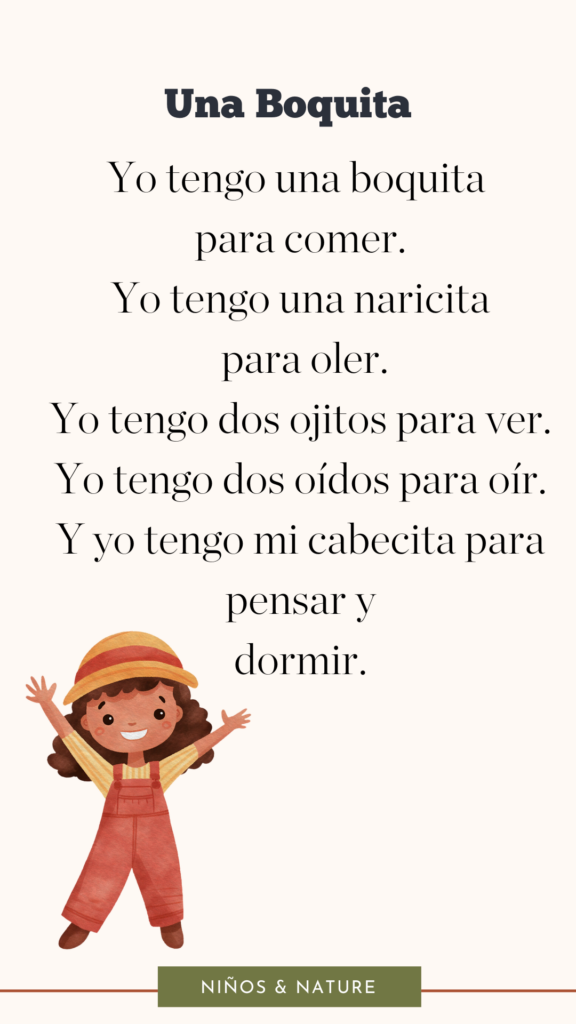
Ahí Viene la Luna
This rhyme introduces the moon in a playful way, perfect for bedtime routines or as part of a moon-themed activity.
Rhyme:
Ahí viene la luna
comiendo tuna,
echando las cáscaras
en esta laguna.
Pollito Chicken
A fun bilingual rhyme that introduces common vocabulary in both Spanish and English, perfect for bilingual homes.
Rhyme:
Pollito, chicken,
gallina, hen,
lápiz, pencil
y pluma, pen.
Ventana, window,
puerta, door,
maestra, teacher
y piso, floor.
Adiós Burbujas
A gentle Spanish goodbye rhyme, great for ending activities or transitioning to a new one.
Rhyme:
Burbujitas, burbujitas,
ya me voy, ya me voy,
déjame decirte, déjame decirte
adiós, adiós.
Burbujitas, burbujitas,
ya se van, ya se van,
déjame decirles, déjame decirles
adiós, adiós.
Estaba la Pájara Pinta
A traditional rhyme that is perfect for reciting in a circle, bringing movement and rhythm to the lyrics.
Rhyme:
Estaba la pájara pinta
sentada en un verde limón
con el pico recoge la hoja
con la hoja recoge la flor
¡Ay, ay, ay! ¿Dónde estará mi amor?
Spanish Nursery Rhyme Books We Love
Sing Along with These Spanish Nursery Rhyme Videos
Watch and learn 10 fun Spanish nursery rhymes with the videos below! You can learn them on your own and then teach your kiddos, or watch the videos together and learn alongside each other.
Los Pollitos Dicen pío pío pío
Los pollitos dicen
pío pío pío
cuando tienen hambre
cuando tienen frío.
La gallina busca
el maíz y el trigo
les da la comida
y les presta abrigo.
This is one of my absolute favorite nursery rhymes that I have learned with my own kids. I started singing it to them as babies and now, as 4 year olds, they know it well. Check out these super cute baby chick crafts to do while you learn this Spanish poem.
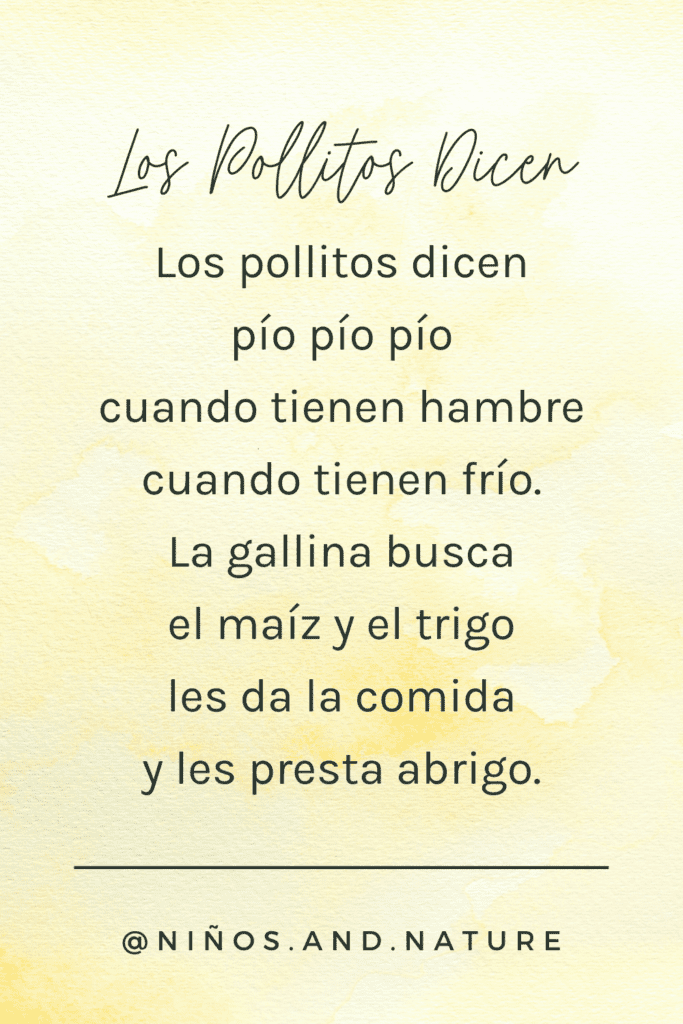
Tengo, tengo, tengo
Tengo, tengo, tengo,
tú no tienes nada,
tengo tres ovejas en una cabaña.
Una me da leche,
otra me da lana,
otra me mantiene toda la semana.
Caballito blanco,
llévame de aquí,
llévame hasta el pueblo
donde yo nací.
La Vaca Lola
La vaca Lola, la vaca Lola,
Tiene cabeza y tiene cola,
La vaca Lola, la vaca Lola,
Tiene cabeza y tiene cola,
y hace “muu.”
Another favorite for us! We love animals and nature at my house, so this little Spanish poem about a vaca named Lola was an instant hit. The repetition really helps your kids remember this one quickly too! This would be a great rhyme to start with. Bonus points if you make one of these sweet little cow crafts with your kids while you learn!
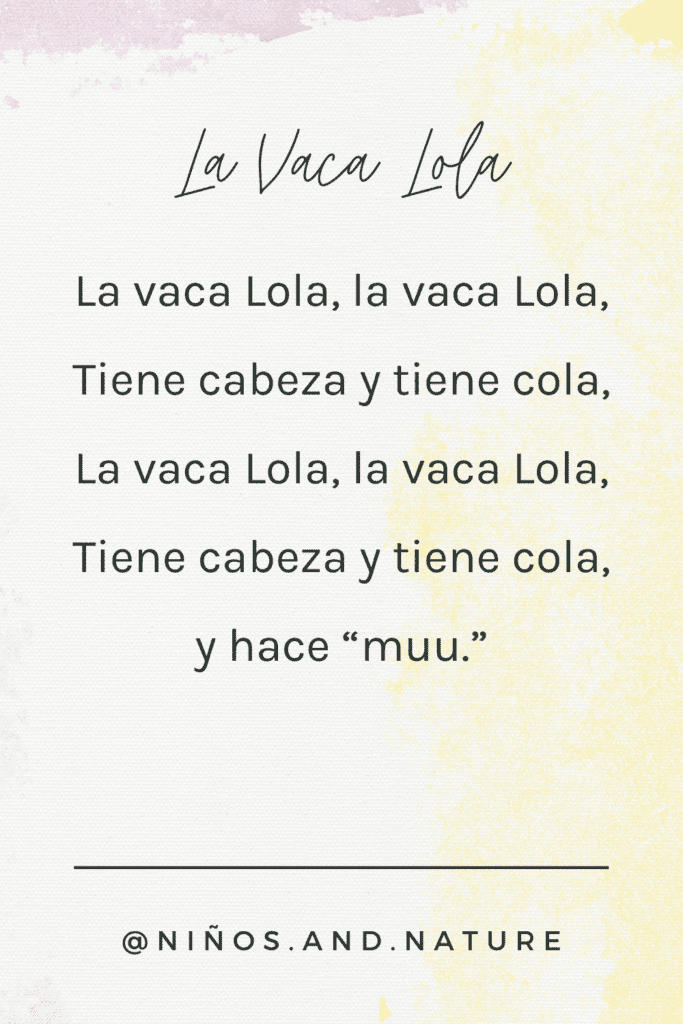
La Araña Pequiñita
La araña pequiñita
subió, subió, subió,
Vino la lluvia
Y se la llevó
Salió el sol
Y todo lo secó
Y la araña pequiñita
Subió, subió, subió
This is such a fun Spanish song and nursery rhyme to learn with your bilingual children! If you don’t feel like singing it, no worries! You can recite it just like a poem. Want a fun craft project to do with this? Check out these super cute spider crafts to help bring your Spanish learning to life!
Estrellita ¿Dónde estás?
Estrellita, ¿dónde estás?
Quiero verte titilar
En el cielo sobre el mar,
Un diamante de verdad.
Estrellita, ¿dónde estás?
Me pregunto qué serás.

Another classic song for kids! There are so many special projects you can make to turn this rhyme into a hands-on language lesson for your kids. Try making some of these paper stars with your little ones!
Pin Pon
Pin pon es un muñeco
muy guapo y de cartón
se lava la carita con agua y con jabón.
Pin pon siempre se peina
con peine de marfil
y aunque se hace tirones
no llora ni hace así.
Pin pon dame la mano
con un fuerte apretón
yo quiero ser tu amigo
pin pon pin pon pin pon.
Somos como las Flores
Somos como las flores
En el jardín de la vida
Somos como las flores
Necesitamos la lluvia y el sol.
Sol, caliénteme
Luna, arrúllame
Brisa, refréscame
Tierra, aliméntame

Sol Solecito
Sol, solecito, caliéntame un poquito,
por hoy, por mañana, por toda la semana,
luna lunera, cascabelera,
cinco pollitos y una ternera,
caracol, caracol, a la una sale el sol
sale pinocho tocándo el tambor,
con una cuchara y un tenedor.
Arroz Con Leche
Arroz con leche
Me quiero casar
Con una viudita
de la capital
Que sepa coser
Que sepa bordar
Que sepa abrir la puerta
Para ir a jugar
I love this alternative version to the traditional nursery rhyme:
Sana Sana
Sana sana, colita de Rana,
si no sanas hoy, sanarás mañana.
Spanish Workbooks for Bilingual Kids
If you loved these nursery rhymes and want to continue your child’s bilingual journey, check out my Spanish workbooks and notebooks designed specifically for bilingual kids! These resources offer hands-on, engaging activities that make learning Spanish fun and interactive.
From creative writing prompts to nature-based vocabulary builders, my materials help kids enhance their Spanish skills while sparking their imagination. Whether you’re homeschooling, supplementing school lessons, or looking for educational activities to do at home, these workbooks are perfect for providing quality Spanish input in a way your kids will love!
Explore my full collection and give your child the tools they need to thrive as a bilingual learner!
Alright my friends, I hope you love these fun Spanish songs and rhymes as much as I do! Whether you are learning Spanish at home with your children, or you are a Spanish teacher looking for new ways to teach your students, I hope this blog post helps. If you’re wanting even more Spanish learning for your young kids, check out my Spanish courses!
Like this post? Share & save it!
